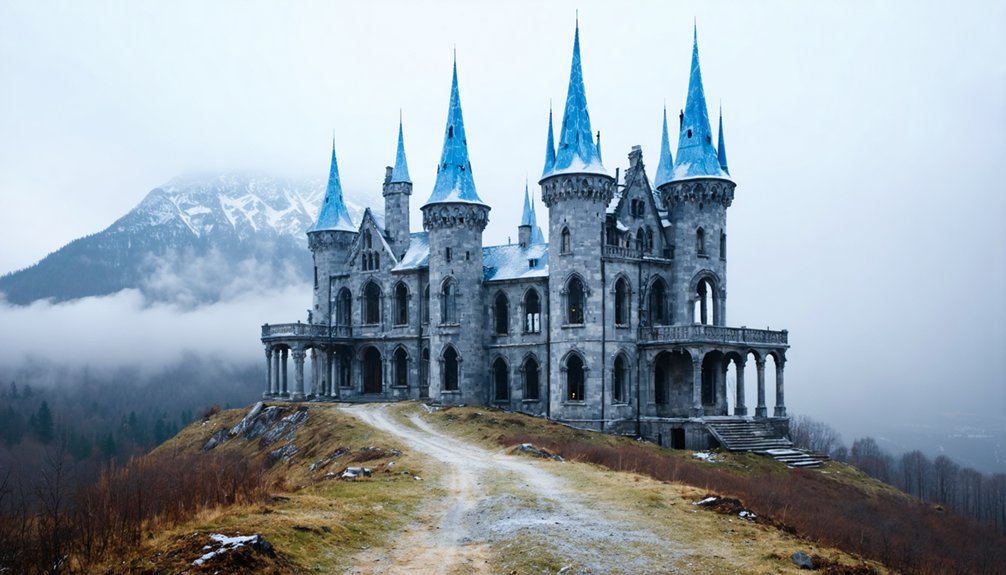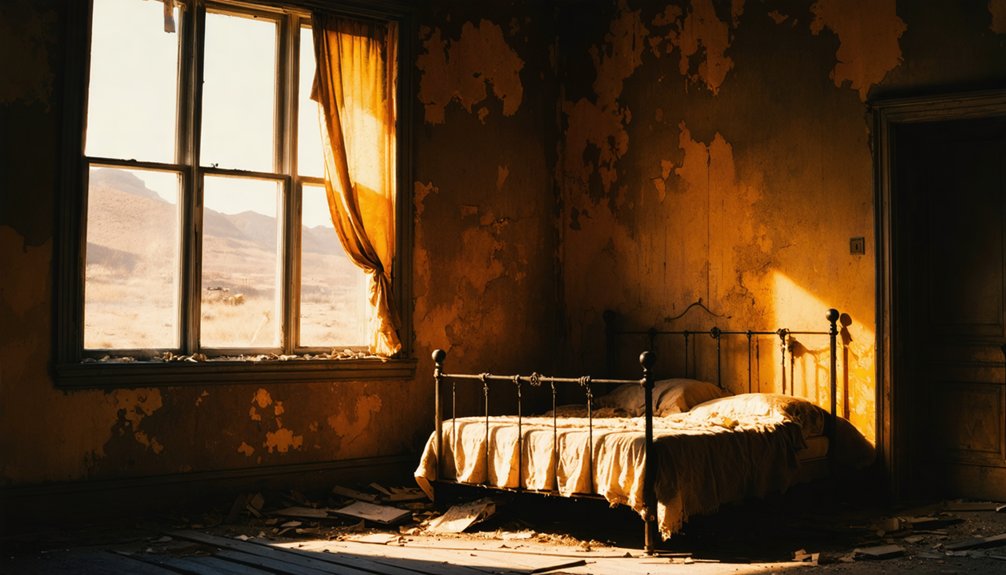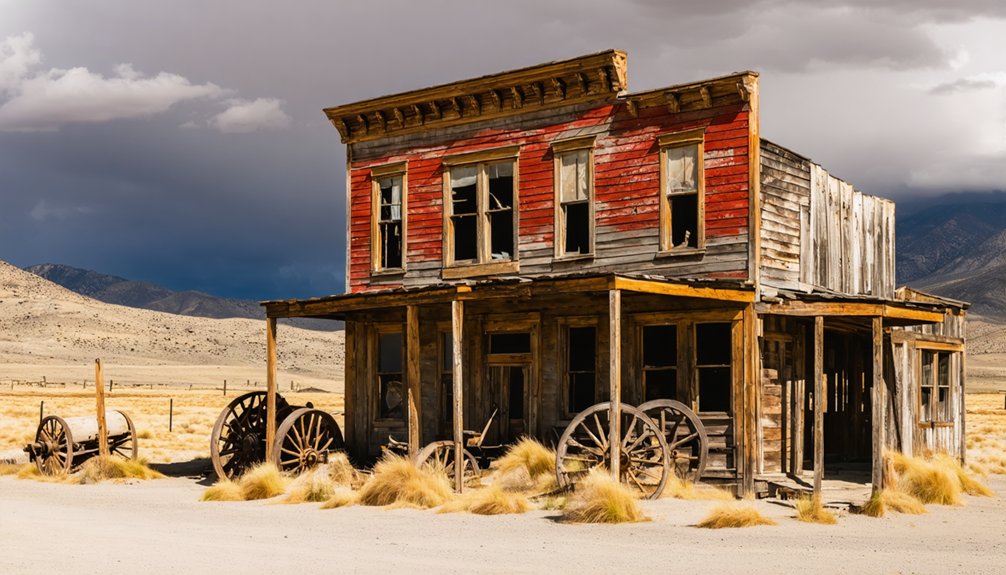Burj Al Babas is an abandoned development of 587 identical Gothic-style mini-châteaux in Turkey’s Bolu Province. You’ll find this $200 million project frozen in time after its developers went bankrupt in 2018, leaving behind a surreal landscape of cookie-cutter castles. What began as luxury homes for wealthy Middle Eastern buyers now stands as a monument to architectural hubris, cultural tone-deafness, and economic folly. The ghostly remains tell a cautionary tale of excess.
Key Takeaways
- Burj Al Babas is an abandoned $200 million luxury development in Turkey featuring 732 identical Gothic-style mini-châteaux.
- The project collapsed in 2018 when Sarot Property Group filed for bankruptcy with $24 million in debt.
- Originally priced at $370,000-$500,000 per villa, the development targeted wealthy Middle Eastern buyers seeking European fantasy lifestyles.
- The site now functions as a ghost town and popular urban exploration destination with structures in various states of deterioration.
- Developers face potential 885-year prison sentences for allegations of orchestrating a $67 million fraud scheme.
The Gothic Fairy Tale That Never Was
While Disney-inspired dreams guided the architectural vision of Burj Al Babas, the reality materialized as nothing more than a grotesque caricature of European nobility.
The fairy-tale facade crumbled to reveal a tacky imitation—European grandeur reduced to theme-park mockery.
You’d expect authentic castle architecture when paying upwards of $500,000, but instead received foam towers and fiberglass turrets masquerading as luxury.
The developers envisioned 732 mini-châteaux sprawling across the Turkish countryside—a surreal landscape designed to attract wealthy Middle Eastern buyers seeking European fantasy.
This architectural travesty reveals how easily genuine cultural aesthetics become commodified for tourism implications.
Within three years, the cheap materials began deteriorating. Wind damaged the hollow towers, exposing bare concrete and missing roof tiles throughout the development. The project faced numerous legal challenges including unpaid worker wages and environmental law breaches.
The project stalled in 2018 when Sarot Group filed for bankruptcy in November, leaving approximately 587 houses abandoned in various states of completion.
What remains is a haunting monument to excess—hundreds of identical fake castles standing empty in rural Turkey, their marble floors and promised spas never to be enjoyed.
Origins of Turkey’s Castle City Mirage
You’re witnessing the aftermath of an architectural fever dream that began when Dubai-based Sarot Property Group and Turkey’s Yerdelen brothers committed $200 million to building 732 luxury mini-castles in rural Bolu Province.
Their extravagant vision—a Disney-like collection of European-inspired châteaux with Gothic towers and conical roofs—rejected local Turkish architectural traditions in favor of selling a fantastical lifestyle to wealthy foreign buyers.
The project’s collapse amid falling oil prices and political instability stands as a cautionary monument to development hubris, leaving behind hundreds of identical turreted structures that now form a surreal, uninhabited landscape. The development was named after Babas Kaplıcası, a historic Ottoman-era thermal spring located near the construction site. This abandoned luxury development sits strategically halfway between Istanbul and Ankara, making it initially attractive as a vacation destination for affluent city dwellers.
Gold Rush Gone Wrong
In what might be considered the ultimate real estate fantasy gone wrong, Turkey’s Burj Al Babas development represents a cautionary tale of gold-rush mentality in luxury property markets.
The $200 million venture crashed spectacularly when developers misjudged both their market and economic conditions.
You’re witnessing the aftermath of flawed assumptions about wealthy Middle Eastern buyers’ interest in remote Turkish castles priced at half a million dollars each.
When oil prices plummeted and the Turkish lira collapsed, the project’s economic implications became devastating. Buyers fled, loans couldn’t be repaid, and by 2018, bankruptcy followed with $24 million in debt.
The fairy-tale architecture that ignored local heritage, combined with unfinished amenities and infrastructure, transformed this real estate dream into a surreal monument to overambition. The environmental impact was equally devastating, with a 100-year-old forest destroyed to make way for the doomed castle complex.
Though construction halted in 2018, a glimmer of hope emerged when NOVA Group Holdings acquired the project with intentions to revive development for Gulf clients.
Fantasy Architecture’s Empty Promise
Despite its fantastical façade, Burj Al Babas represents the hollow core of architectural fantasy detached from cultural reality.
Initiated in 2014 by Istanbul’s Sarot Group, this Disney-esque development promised middle and upper-class buyers their own miniature château for $370,000-$500,000.
You’re witnessing the ultimate architectural dreams gone wrong—732 identical Gothic-inspired castles with turrets and conical roofs that clash jarringly with traditional Ottoman surroundings.
The development ignored local culture, cleared century-old forests, and alienated communities while promising artificial luxury.
Originally intended to capitalize on nearby natural hot springs, the project failed to balance exploitation of natural resources with sustainable development principles.
When Turkey’s economic crisis hit and oil prices fell, fantasy disillusionment quickly followed.
Now frozen in time with 583 abandoned structures, this $200 million folly stands as a monument to speculative development that prioritized fantastical aesthetics over community needs and environmental sustainability.
Architectural Fantasy Meets Fiscal Reality
You’re witnessing the inevitable collapse of architectural hubris at Burj Al Babas, where 732 cookie-cutter Gothic castles stand abandoned after developers exhausted $200 million on a fantasy that ignored market realities.
The Sarot Group’s bankruptcy in 2019 left hundreds of half-finished villas without doors, windows or finishing touches—concrete shells of broken promises to Middle Eastern investors.
These identical turrets and ornate facades now deteriorate in eerie rows, monuments to disconnected vision and financial overreach that failed to respect either local cultural context or sustainable development principles. Originally developed by Istanbul-based developers Violent Yilmas and the Urdelin Brothers, this ghostly development has become an inadvertent attraction for urban explorers despite its failed purpose. Located in the Bolu Province of Turkey, this ghostly development has become an inadvertent attraction for urban explorers despite its failed purpose.
Gothic Dreams Bankrupt
Grandiose visions of a French-inspired luxury enclave crashed against fiscal reality when the Sarot Group’s ambitious Burj Al Babas project collapsed under its own extravagance.
You’re witnessing the aftermath of a $200 million miscalculation. The 583 completed gothic architecture mini-castles stand eerily vacant, their blue-gray conical roofs punctuating the Turkish landscape like a fever dream.
Financial mismanagement collided with market forces when the 2018 Turkish economic crisis sent the lira plummeting, evaporating Arab investment interest.
What began as a playground for wealthy tourists now serves as a monument to developmental hubris. The uniform French chateaux, with their ornate facades and turrets, ignore local cultural context while exposing the fragility of luxury speculation.
These abandoned shells, stripped of their fairy-tale promise, reveal the hollow core beneath aspirational real estate ventures. Initially intended to house 732 luxury villas, the incomplete structures now attract only urban explorers and armed guards protecting the ghostly remains of shattered dreams.
Copied Castles, Empty Vaults
The architectural fantasy of Burj Al Babas reveals itself most clearly through its formulaic reproduction of European grandeur, stripped of cultural context and authentic craftsmanship.
You’re witnessing 587 identical castle replicas crammed onto tiny plots—each a caricature of French château architecture with their cookie-cutter turrets and conical blue-gray roofs.
These $200 million worth of faux-aristocratic dreams stand as monuments to spectacular investment failures.
What developers promised as luxury—marble floors and private Jacuzzis—couldn’t overcome the fundamental absurdity: a forest sacrificed for identical mini-castles built with industrial foam and fiberglass.
While developers face potential 885-year prison sentences for fraud, you’re left contemplating the empty vaults—both financial and cultural—of a development that prioritized Gulf wealth attraction over environmental stewardship and authentic Turkish architectural heritage.
A $200 Million Monument to Excess
Folly stands frozen in concrete at Burj Al Babas, where a staggering $200 million investment transformed a picturesque Turkish landscape into a surreal tableau of abandoned opulence.
You’re witnessing excessive ambition crystallized in 587 cookie-cutter chateaux, each priced between $370,000 and $500,000 – symbols of a development model that prioritized luxury aesthetics over economic sustainability.
This architectural folly employed 2,500 workers at its peak before Turkey’s 2018 economic crisis and falling oil prices shattered the project’s financial foundation.
What remains is a cautionary monument – half-finished interiors behind ornate facades, scattered construction materials, and unfinished roads stretching between empty structures.
The developers’ dream of attracting wealthy Gulf tourists to thermal hot springs collapsed, leaving behind this eerie reminder of how quickly grand visions crumble when disconnected from economic reality.
Cultural Dissonance in the Black Sea Region
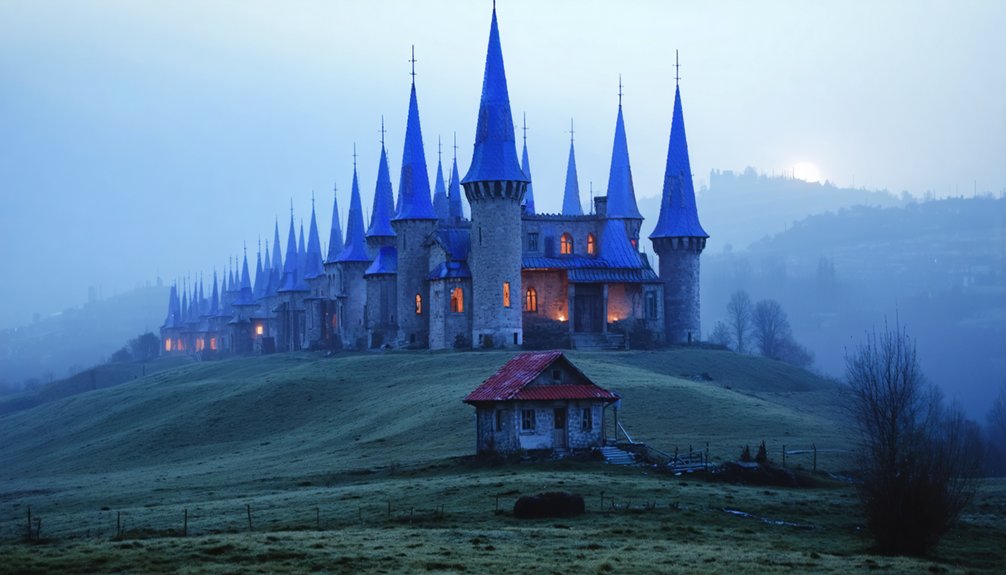
While Burj Al Babas may represent architectural excess in its most concentrated form, it also embodies a profound cultural mismatch with the Black Sea region’s rich tapestry of identities and traditions.
The project’s Disney-like Gothic castles stand in jarring contrast to a landscape where Ottoman architecture, Pontic Greek influences, and traditional Black Sea building styles have evolved organically for centuries.
At these cultural intersections, communities like the Laz and Muslim Pontic Greeks maintain endangered languages and unique cultural practices that find no reflection in Burj Al Babas’s design philosophy.
While Turkey has initiated heritage preservation laws since 2018 to protect architectural authenticity, projects like this undermine the region’s socio-cultural fabric.
They sacrifice authentic cultural expression for profit, ignoring the complex religious and ethnic diversity that gives the Black Sea region its distinctive character.
The Eerie Allure of Abandoned Luxury
Standing frozen in time on Turkey’s northern plains, Burj Al Babas offers a haunting monument to abandoned opulence that contrasts sharply with the region’s authentic cultural heritage.
As you wander through this eerie collection of 732 identical mini-castles, you’ll encounter a surreal landscape of Gothic turrets and ornate balconies slowly succumbing to nature’s reclamation.
The uniformity of these $500,000 villas amplifies their spectral quality—a dystopian vision of luxury frozen mid-creation. What was meant to be an exclusive playground for wealthy Middle Eastern buyers has transformed into an unconventional tourist attraction celebrated for its abandoned beauty.
This $200 million ghost town represents the ultimate failure of imposing foreign architectural fantasies onto local landscapes, creating an unintentional monument to capitalist excess that’s simultaneously repellent and strangely enthralling.
Legal Aftermath and Criminal Allegations
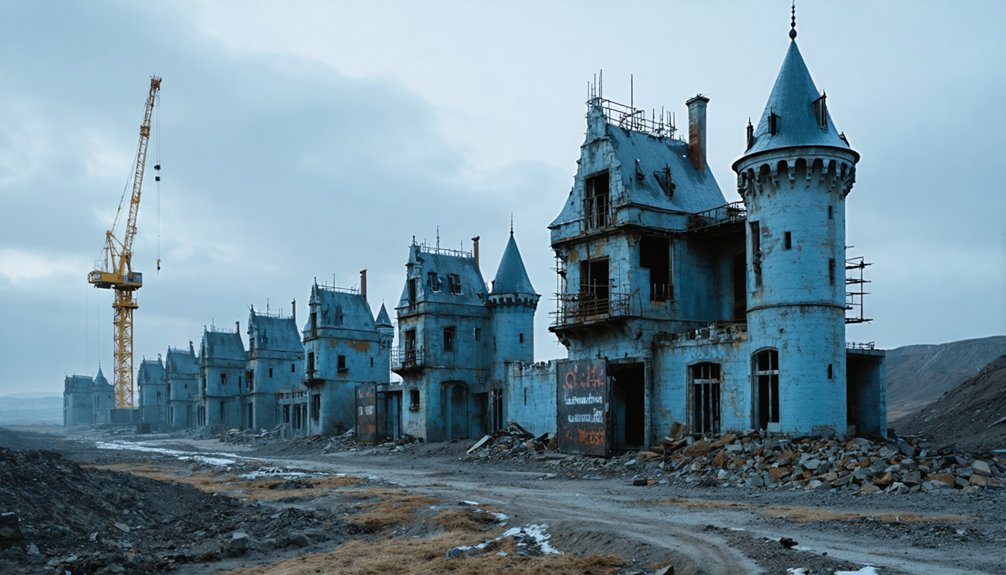
Beyond its haunting façade, Burj Al Babas represents one of Turkey’s most extensive legal quagmires, with criminal allegations that transform this architectural folly from mere business failure into potential organized fraud.
You’re witnessing the aftermath of what prosecutors call deliberate deception, not just ambitious overreach. Developers now face staggering 885-year potential sentences each for allegedly orchestrating a $67 million scam with no intention of completing the promised villas.
The legal battlefield extends beyond criminal charges to multiple fronts: investor lawsuits demanding refunds, environmental litigation over destroyed forests and privatized thermal springs, contractor disputes that escalated to violence, and complex bankruptcy proceedings.
Despite courts declaring the company “comfortably in credit” in 2022, the government seized control through a state-run fund before selling to Nova Group Holdings—leaving legal disputes unresolved and investors empty-handed.
From Resort Dream to Accidental Tourist Attraction
Though conceived as an exclusive desert playground for wealthy Gulf investors, Burj Al Babas’ transformation into Turkey’s most photographed ghost town reveals the spectacular implosion of unrestrained developmental hubris.
You’ll find this abandoned dreamscape has achieved unintended tourist appeal, drawing urban explorers, photographers, and curiosity-seekers to its eerie rows of identical Gothic turrets.
The architectural irony is unmistakable—structures meant to house the ultra-wealthy now stand as hollow monuments to economic folly, their Disney-inspired aesthetics frozen in developmental purgatory.
What was designed as a luxury escape has become something more authentic—a cautionary landscape where visitors contemplate the consequences of unsustainable development.
Without completed interiors or infrastructure, these cookie-cutter castles offer a more valuable experience than originally intended: a visceral lesson in the limitations of artificial opulence.
The Future of Turkey’s Ghost Castle Town
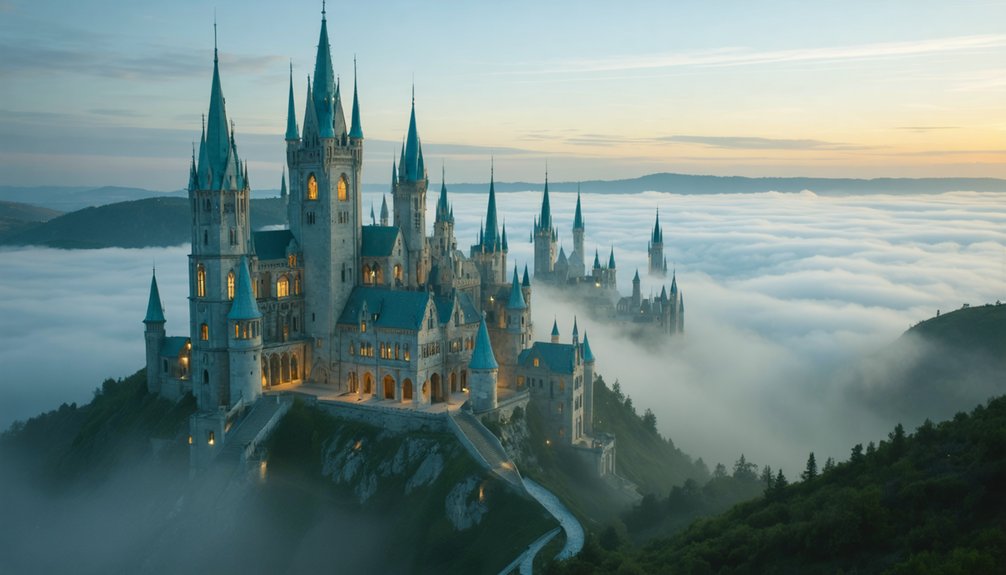
While bankruptcy proceedings and fraud investigations cloud Burj Al Babas’ immediate prospects, this surreal collection of abandoned mini-castles exists in a peculiar developmental limbo.
You’ll find no concrete plans for future redevelopment, despite the developer’s optimistic claims that selling just 100 villas could resurrect the project.
The legal entanglements involving 13 suspects facing potential 885-year sentences complicate any straightforward resolution.
Meanwhile, the site thrives unofficially as an urban exploration hotspot, drawing photographers and content creators despite trespassing concerns.
Abandoned castle streets find new life through lens-wielding explorers, transforming architectural failure into viral content gold.
This unintended purpose might ultimately prove more viable than its original vision.
The project stands as a cautionary monument to unsustainable development—a $67 million fairytale suburb without infrastructure, community input, or economic foundation, leaving both investors and the landscape in suspended animation.
Frequently Asked Questions
Can Individual Castles Be Purchased Now at Discounted Rates?
Individual castles may be unofficially available around $50,000, but you’ll face significant risks with castle resale—unfinished structures, disputed ownership, and minimal buyer interest in this failed development.
What Ecological Impact Did Construction Have on the Surrounding Environment?
You’ll find the project left a devastating ecological footprint, destroying acres of pine forest, disrupting essential wildlife habitat, damaging water resources, and causing soil degradation through irresponsible construction practices and debris dumping.
Have Any Paranormal Activities Been Reported at the Site?
No, you won’t find ghost sightings or haunted legends here. The eerie feeling comes purely from the dystopian landscape of identical abandoned castles—a monument to failed development rather than supernatural activity.
How Do Locals From Mudurnu Feel About the Abandoned Project?
You’ll find that 60% of Mudurnu residents remain divided—some view it as a wasted opportunity, others as a cultural eyesore. Local sentiment varies between economic disappointment and relief over preserved heritage. Community impact remains unresolved.
Are There Plans to Use the Site for Filming Opportunities?
You’ll find no official plans for site utilization through filming opportunities, though Alexandra Hum’s short film demonstrates interest. Security restrictions, ownership disputes, and logistics challenges currently limit creative development potential.
References
- https://bigthink.com/the-present/burj-al-babas/
- https://aroundus.com/p/9677114-burj-al-babas
- https://travelfeed.com/@geekontheroad/burj-al-babas
- https://www.youtube.com/watch?v=X7ji_XDK_pA
- https://bacheloroftravel.com/burj-al-babas-what-you-need-to-know-about-turkeys-abandoned-disney-castle-village/
- https://www.youtube.com/watch?v=627HvFA6M5I
- https://www.youtube.com/watch?v=xCUFJwv_O1k
- https://www.islands.com/1805159/eeriest-destination-turkey-modern-ghost-town-burj-al-babas-hundreds-uninhabited-fairytale-castles/
- https://www.travelawaits.com/2660201/burj-al-babas-turkey-castle-ghost-town/
- https://www.youtube.com/watch?v=5WSPiSyf854
